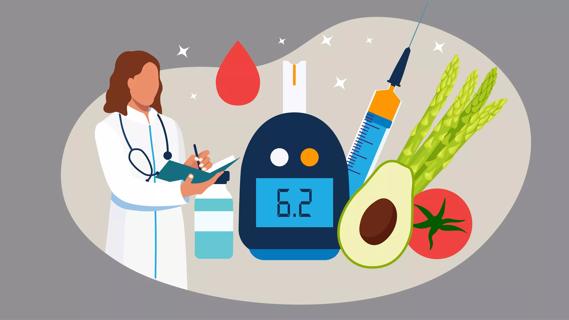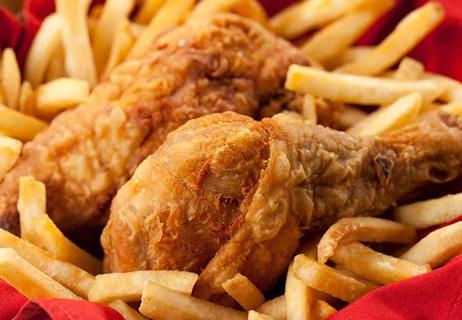Lifestyle changes like diet and exercise can help

People who have prediabetes have up to a 50% chance of developing Type 2 diabetes within five to 10 years — but it’s not a done deal. There are steps you can take to prevent it from happening.
Advertisement
Cleveland Clinic is a non-profit academic medical center. Advertising on our site helps support our mission. We do not endorse non-Cleveland Clinic products or services. Policy
“Early intervention is absolutely key,” says endocrinologist Shirisha Avadhanula, MD. “Studies show that lifestyle interventions can be just as good as some of our standard diabetic treatment for the progression of prediabetes to Type 2 diabetes.”
She explains what prediabetes is, what it means for your health and what you can do to reverse it.
“Pre” means “before,” so “prediabetes” is exactly what it sounds like; it’s a state before you develop Type 2 diabetes. When you have prediabetes, your blood sugar levels are higher than normal, but not yet high enough to be considered Type 2 diabetes.
“Diabetes is a metabolic and endocrine dysfunction, a state in which too much sugar accumulates in your blood,” Dr. Avadhanula explains. “This sugar can then deposit into small blood vessels in the body, which canthen lead toorgan dysfunction.”
If prediabetes goes unmanaged, it can turn into Type 2 diabetes. But it doesn’t have to.
“This can be an elongated process that happens over time,” Dr. Avadhanula says. That means you have a chance to make some important lifestyle changes that can help your body reverse course.
There are some risk factors you can’t control, like genetics. But lifestyle changes also play a major role in reversing prediabetes and preventing Type 2 diabetes. Dr. Avadhanula explains what you can do.
Advertisement
Let’s start with this important acknowledgment: It can be really difficult and overwhelming to try to overhaul your lifestyle. But you don’t have to do it alone.
“Patient education is so important because many people may not know what healthy choices are,” Dr. Avadhanula says. “As doctors, we often send patients to nutritionists to learn about calories, what foods are best for them and which ones aren’t good choices.”
Your healthcare providers can also talk to you about how to access healthy foods and learn to read nutrition labels. This is especially important if you live in a low-income or marginalized community where, studies show, diabetes rates are highest.
Obesity is a major risk factor for insulin resistance, which means your body can’t properly regulate blood sugar levels.
“The best way to reverse the prediabetes process and for you not to develop Type 2 diabetes is weight loss,” Dr. Avadhanula notes. “As we gain more weight, our cells become more and more resistant to the effects of insulin. And unfortunately, insulin resistance is the first key step in developing Type 2 diabetes.”
It can be discouraging to think about the long haul of trying to lose weight. But losing even 5% of your body weight can have a significant impact on your health, including your blood sugar.
In fact, research shows that you can reduce your risk of developing Type 2 diabetes by as much as 58% when you lose 5% to 7% of your body weight and work out at least 150 minutes per week (more on that in a minute).
There’s no one style of eating that’s best for reversing prediabetes, so Dr. Avadhanula says the key is to find one that works for you.
“You want to aim for caloric restriction, but there are many different pathways to get there,” she says. “The most important thing is that you’re able to adhere to whatever healthy eating style you pick.” Good options include:
A word of caution, though: “Diets can be detrimental and even unsafe on your own, so you should start them under close monitoring of a healthcare provider,” Dr. Avadhanula says. Your doctor can guide you or connect you with a nutritionist.
Your blood sugar levels are directly related to how much sugar you consume, so eating fewer calories doesn’t just mean … well, eating fewer calories. It also means making sure that those calories come from healthier, more nutrient-rich foods.
“It’s important to watch your calorie intake, but you also have to think about the quality of the foods you’re consuming,” Dr. Avadhanula says. “Let’s say I ask you to consume 1,400 calories in a day. If you just consume 1,400 calories of candy, that will not be helpful for your blood sugar.”
Advertisement
To the best of your ability, eliminate sugary foods like:
If you don’t know exactly what you’re eating, it’s all too easy to believe that you’re eating well. But the best way to understand exactly what you’re consuming and where you can make changes is to start reading nutrition labels.
“I always encourage my patients to be educated about anything they’re consuming,” Dr. Avadhanula says. “It’s very important to read food labels and to know exactly what you’re eating.”
Getting your body moving can get your blood sugar numbers moving in the right direction, too. The American Diabetes Association recommends 150 minutes of moderate-intensity exercise per week.
That comes out to about 30 minutes a day for five days a week — but it doesn’t have to be all at once. Dr. Avadhanula recommends doing what she calls “exercise snacks,” or shorter bursts of exercise.
“We sometimes ask patients to do 15 minutes of exercise a day twice a day during the work week,” Dr. Avadhanula says. “If you get an hour for lunch, for example, take the last 15 minutes to do some moderate-intensity exercise, and then do the same again at the end of the day.”
Advertisement
Trying to get in your 10,000 steps per day? Add some extra movement to your daily life by taking the stairs instead of the elevator, walking during work calls, parking a little bit farther away from your destination and finding other hacks to help you fit them all in.
And though you may feel inclined to call it a day once you hit 10k, don’t stop there! Dr. Avadhanula says the 10,000-steps-a-day guideline doesn’t replace the need for additional exercise.
“Those steps are the baseline we should be getting each day, in addition to 150 minutes of exercise in a week,” she says.
Sleep is a critical factor in so much of our health, and prediabetes is no different.
Studies show that your levels of cortisol, a hormone from your adrenal gland, should be low at 3:00 a.m. — and a high cortisol level at this time can negatively impact your blood sugar.
“Patients that don’t sleep seven to nine hours of sleep or who aren’t asleep between the hours of 11:00 p.m. and 5:00 a.m. (chronically) can have higher levels of cortisol,” Dr. Avadhanula explains. In other words, if your sleep schedule is out of whack, your risk of conditions like diabetes goes up.
That means that if you work the night shift — or are simply prone to staying awake until the wee hours of the morning — you may need to work extra hard to get enough good-quality sleep to keep your risk at bay.
Advertisement
At some point, your physician might suggest medication to help control and reverse your prediabetes.
“Treatment is always individualized and based on a dual decision between a patient and their healthcare provider. Metformin is typically the first line of treatment and standard of care for patients who have Type 2 diabetes,” Dr. Avadhanula says. “Some studies suggest that, along with lifestyle changes, it can help prevent prediabetes from advancing to Type 2 diabetes.”
But medication doesn’t work in a vacuum; those lifestyle changes are still critical. “I always try to help patients change their lifestyle habits before introducing medications,” she adds.
You can monitor your blood sugar levels using an at-home blood sugar check, which typically involves sticking your finger with a small needle. You put a drop of blood onto a test strip that then displays your blood sugar level.
But you shouldn’t do it too often. “If you have prediabetes, I would caution you against checking your blood sugars multiple times in a day,” Dr. Avadhanula says. “It can be anxiety-provoking and counterproductive.”
Instead, check your fasting blood sugar first thing in the morning — and don’t check it again until the next morning. If you’re interested in seeing your blood sugar patterns, a continuous glucose monitor is a better option than daily blood sugar checks.
“It allows you to see how your glucose progresses throughout the day, which can give you a sense of which foods cause your blood sugars to spike,” she says. “It can give you very good insight on how food is affecting your blood sugar.”
If you have prediabetes, it’s important to know that you have prediabetes so that you can start trying to reverse it. But it doesn’t usually cause symptoms.
“The most common symptom is no symptom at all,” Dr. Avadhanula warns, “so if you’re overweight or have obesity, it’s especially important to be tested for prediabetes.”
The Centers for Disease Control and Prevention (CDC) estimates that 80% of people who have prediabetes don’t know they have it. If left untreated, though, prediabetes can turn into Type 2 diabetes, which raises your risk for other health conditions, like amputations, blindness, heart attacks and stroke.
“If you have multiple risk factors, it’s all the more important to be cautious in your lifestyle choices,” Dr. Avadhanula says, “and I’m always in favor of patients advocating for themselves,” Ask your doctor about being tested if you have one or more risk factors, especially if you have obesity and:
Your doctor will likely order a hemoglobin A1c test, which measures the amount of sugar in your blood.
Like so many other questions related to health and wellness, there’s no clear-cut answer to this question.
“There’s no set timeline for when your prediabetes will be reversed or for the conversion from prediabetes to Type 2 diabetes,” Dr. Avadhanula says. “There are, however, factors that can accelerate both processes.”
Gaining weight or taking certain medications can accelerate your transition to Type 2 diabetes, while changing your lifestyle habits can slow and eventually reverse that transition altogether. It can take weeks, months or even years to implement the kind of changes that will take you off the course to Type 2 diabetes. But with hard work and patience, it’s possible.
“Just remember: This is a reversible process,” Dr. Avadhanula reassures. “It may take time, but it certainly can be done. Be kind to yourself, and give yourself some grace.”
To hear more from Dr. Avadhanula on this topic, listen to the Health Essentials Podcast episode, “Preventing and Reversing Prediabetes.” New episodes of the Health Essentials Podcast publish every Wednesday.
Learn more about our editorial process.
Advertisement

Hot, humid weather can affect your blood sugar levels and even cause dehydration or heat stroke

The good news? Prediabetes can be erased with healthy lifestyle changes, including eating more nutritious foods

Fresh or frozen fruits that are low on the glycemic index should be your go-to, as they’re full of fiber and other nutrients

Adding nuts like pistachios, almonds or pecans to your diet can help manage blood sugar levels

A diabetes diagnosis, new or long-standing, can trigger reactions like grief, stress, depression and frustration, but symptom relief and help are available

You can counter the risk of prediabetes-related heart attack or stroke by eating more fruits, vegetables and whole grains, as well as exercising regularly

The short answer: Yes, but you need to eat it in moderation and keep track of how much you consume

Sweet potatoes are great, but sweetened drinks aren’t so great

Babies can get congested easily, but you can calm their cough by keeping them hydrated, using nasal drops and running a humidifier

Weight loss may cause loose, sagging skin and muscle loss to your rear

Several conditions, like vitiligo and fungal infection, can cause a loss of pigmentation, leading to white spots or patches on your skin